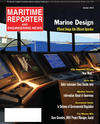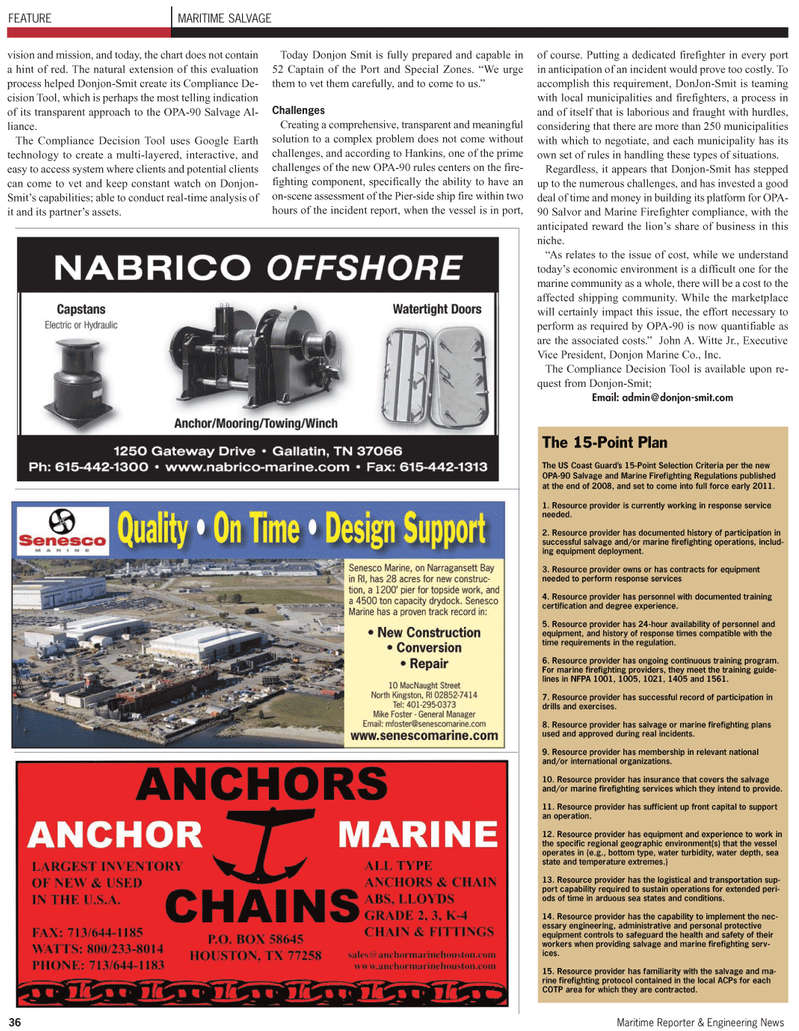
Page 36: of Maritime Reporter Magazine (February 2, 2010)
Read this page in Pdf, Flash or Html5 edition of February 2, 2010 Maritime Reporter Magazine
vision and mission, and today, the chart does not contain a hint of red. The natural extension of this evaluation process helped Donjon-Smit create its Compliance De- cision Tool, which is perhaps the most telling indication of its transparent approach to the OPA-90 Salvage Al- liance.
The Compliance Decision Tool uses Google Earth technology to create a multi-layered, interactive, and easy to access system where clients and potential clients can come to vet and keep constant watch on Donjon-
Smit’s capabilities; able to conduct real-time analysis of it and its partner’s assets.
Today Donjon Smit is fully prepared and capable in 52 Captain of the Port and Special Zones. “We urge them to vet them carefully, and to come to us.”
Challenges
Creating a comprehensive, transparent and meaningful solution to a complex problem does not come without challenges, and according to Hankins, one of the prime challenges of the new OPA-90 rules centers on the fire- fighting component, specifically the ability to have an on-scene assessment of the Pier-side ship fire within two hours of the incident report, when the vessel is in port, of course. Putting a dedicated firefighter in every port in anticipation of an incident would prove too costly. To accomplish this requirement, DonJon-Smit is teaming with local municipalities and firefighters, a process in and of itself that is laborious and fraught with hurdles, considering that there are more than 250 municipalities with which to negotiate, and each municipality has its own set of rules in handling these types of situations.
Regardless, it appears that Donjon-Smit has stepped up to the numerous challenges, and has invested a good deal of time and money in building its platform for OPA- 90 Salvor and Marine Firefighter compliance, with the anticipated reward the lion’s share of business in this niche. “As relates to the issue of cost, while we understand today’s economic environment is a difficult one for the marine community as a whole, there will be a cost to the affected shipping community. While the marketplace will certainly impact this issue, the effort necessary to perform as required by OPA-90 is now quantifiable as are the associated costs.” John A. Witte Jr., Executive
Vice President, Donjon Marine Co., Inc.
The Compliance Decision Tool is available upon re- quest from Donjon-Smit;
Email: [email protected] 36 Maritime Reporter & Engineering News
FEATURE MARITIME SALVAGE
The 15-Point Plan
The US Coast Guard’s 15-Point Selection Criteria per the new
OPA-90 Salvage and Marine Firefighting Regulations published at the end of 2008, and set to come into full force early 2011. 1. Resource provider is currently working in response service needed. 2. Resource provider has documented history of participation in successful salvage and/or marine firefighting operations, includ- ing equipment deployment. 3. Resource provider owns or has contracts for equipment needed to perform response services 4. Resource provider has personnel with documented training certification and degree experience. 5. Resource provider has 24-hour availability of personnel and equipment, and history of response times compatible with the time requirements in the regulation. 6. Resource provider has ongoing continuous training program.
For marine firefighting providers, they meet the training guide- lines in NFPA 1001, 1005, 1021, 1405 and 1561. 7. Resource provider has successful record of participation in drills and exercises. 8. Resource provider has salvage or marine firefighting plans used and approved during real incidents. 9. Resource provider has membership in relevant national and/or international organizations. 10. Resource provider has insurance that covers the salvage and/or marine firefighting services which they intend to provide. 11. Resource provider has sufficient up front capital to support an operation. 12. Resource provider has equipment and experience to work in the specific regional geographic environment(s) that the vessel operates in (e.g., bottom type, water turbidity, water depth, sea state and temperature extremes.) 13. Resource provider has the logistical and transportation sup- port capability required to sustain operations for extended peri- ods of time in arduous sea states and conditions. 14. Resource provider has the capability to implement the nec- essary engineering, administrative and personal protective equipment controls to safeguard the health and safety of their workers when providing salvage and marine firefighting serv- ices. 15. Resource provider has familiarity with the salvage and ma- rine firefighting protocol contained in the local ACPs for each
COTP area for which they are contracted.

 35
35

 37
37
